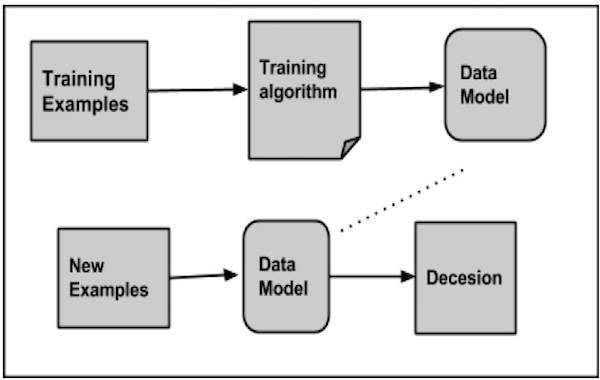
Mahout - Classification
What is Classification?
Classification is a machine learning technique that uses known data to determine how the new data should be classified into a set of existing categories. For example,
iTunes application uses classification to prepare playlists.
Mail service providers such as Yahoo! and Gmail use this technique to decide whether a new mail should be classified as a spam. The categorization algorithm trains itself by analyzing user habits of marking certain mails as spams. Based on that, the classifier decides whether a future mail should be deposited in your inbox or in the spams folder.
How Classification Works
While classifying a given set of data, the classifier system performs the following actions:
- Initially a new data model is prepared using any of the learning algorithms.
- Then the prepared data model is tested.
- Thereafter, this data model is used to evaluate the new data and to determine its class.

Applications of Classification
Credit card fraud detection - The Classification mechanism is used to predict credit card frauds. Using historical information of previous frauds, the classifier can predict which future transactions may turn into frauds.
Spam e-mails - Depending on the characteristics of previous spam mails, the classifier determines whether a newly encountered e-mail should be sent to the spam folder.
Naive Bayes Classifier
Mahout uses the Naive Bayes classifier algorithm. It uses two implementations:
- Distributed Naive Bayes classification
- Complementary Naive Bayes classification
Naive Bayes is a simple technique for constructing classifiers. It is not a single algorithm for training such classifiers, but a family of algorithms. A Bayes classifier constructs models to classify problem instances. These classifications are made using the available data.
An advantage of naive Bayes is that it only requires a small amount of training data to estimate the parameters necessary for classification.
For some types of probability models, naive Bayes classifiers can be trained very efficiently in a supervised learning setting.
Despite its oversimplified assumptions, naive Bayes classifiers have worked quite well in many complex real-world situations.
Procedure of Classification
The following steps are to be followed to implement Classification:
- Generate example data
- Create sequence files from data
- Convert sequence files to vectors
- Train the vectors
- Test the vectors
Step1: Generate Example Data
Generate or download the data to be classified. For example, you can get the 20 newsgroups example data from the following link: http://people.csail.mit.edu/jrennie/20Newsgroups/20news-bydate.tar.gz
Create a directory for storing input data. Download the example as shown below.
$ mkdir classification_example $ cd classification_example $tar xzvf 20news-bydate.tar.gz wget http://people.csail.mit.edu/jrennie/20Newsgroups/20news-bydate.tar.gz
Step 2: Create Sequence Files
Create sequence file from the example using seqdirectory utility. The syntax to generate sequence is given below:
mahout seqdirectory -i <input file path> -o <output directory>
Step 3: Convert Sequence Files to Vectors
Create vector files from sequence files using seq2parse utility. The options of seq2parse utility are given below:
$MAHOUT_HOME/bin/mahout seq2sparse --analyzerName (-a) analyzerName The class name of the analyzer --chunkSize (-chunk) chunkSize The chunkSize in MegaBytes. --output (-o) output The directory pathname for o/p --input (-i) input Path to job input directory.
Step 4: Train the Vectors
Train the generated vectors using the trainnb utility. The options to use trainnb utility are given below:
mahout trainnb
-i ${PATH_TO_TFIDF_VECTORS}
-el
-o ${PATH_TO_MODEL}/model
-li ${PATH_TO_MODEL}/labelindex
-ow
-c
Step 5: Test the Vectors
Test the vectors using testnb utility. The options to use testnb utility are given below:
mahout testnb
-i ${PATH_TO_TFIDF_TEST_VECTORS}
-m ${PATH_TO_MODEL}/model
-l ${PATH_TO_MODEL}/labelindex
-ow
-o ${PATH_TO_OUTPUT}
-c
-seq